Flight bags are too often a necessary evil. Bought with the best intensions, they devolve into a chaotic mess of dead batteries and candy bar wrappers with an expired AF/D thrown in for extra weight. Yet we all need something to carry a headset or two, some charts and flashlight to the airplane and back. How much depends on your mission and whether you own, share or rent.
We took a look at some of the latest pilot bags available, and were pleasantly surprised that there are bags that let you have all the essentials close at hand
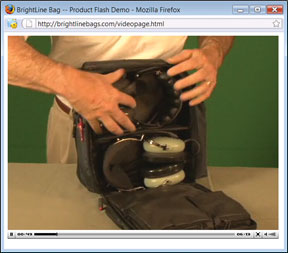
without taking up the entire rear seat.
Brightlines Pocket-fest
Our first impression of the Brightline bag was that it looked like an escapee from a zipper factory. It had so many pockets it seemed to venture beyond basic organization and cross into obsessive-compulsive disorder. Then we used the bag for a few flights … and ended up buying it.
The coup performed by Brightline wasnt simply adding a bunch of pockets-in fact, we don’t think it needs quite so many-it was how it used space. For example, the center compartment was designed primarily with a headset in mind, but headsets come in many sizes. The Brightline solution is just the right size for one bulky headset, such as a Lightspeed 3G upright or two David Clarks on their sides. Pull out one DC headset and you’ll find a complete bag for a GPS also fits in that spot. We even fit the new Garmin 696 and a DC headset in that space.
If youre only using one headset, there is empty space in that compartment, so there are pockets on the inside of the compartment to take advantage of it. The whole bag is ripe with clever arrangements of pockets and space. In fact, when we loaded up the bag with a bunch of typical pilot supplies we were surprised by how heavy it was given that its not that big dimensionally. Then we realized it had somehow swallowed as much stuff as we fit in another bag nearly one-third larger in size.
A cell-phone pocket and, separate, sunglass pocket are on the top of the bag for easy access. There is a two-part chart area that lets you keep all of your charts in a library area, but keep todays charts, or a thin kneeboard in an outer pocket.
Brightline was created by Ross Bishop, an engineer and part-time CFI. He couldnt find a bag that was small enough to be convenient, tall enough to hold sectional or
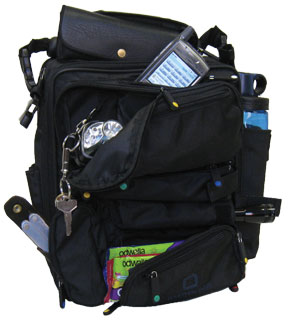
NACO en route charts without folding them and kept the small stuff-keys, sunglasses,Leatherman-from rattling around. He sat down with his CAD software to figure out an orientation that made it all work. In our opinion, he succeeded in spades.
We found only three problems with the Brightline bag. One was that its strength in custom-pocket organization was also a bit of a limitation. There is a pocket designed for a Mini Mag-lite style flashlight right on the outside. Thats great, if you happen to have that flashlight. Our headband flashlight, though, didnt have a good home on any outer pocket. There are enough options that you’ll probably find a spot for everything you need, but its not as simple as a few big pockets that hold everything.
The bag is also too small for a bunch of approach-chart books. Even two medium-size Jepp binders push the limits of that chart pocket. Brightline is looking at making a modular zip-in section or other solutions to widen the usability of the bag. Finally, the bag is expensive at $129. But for that price you get a lot of capability.
Sportys New Lineup
Sportys pilot shop recently released a slew of new flight bags. There were too many to look at every one, but we took a sampling of four: the CFI bag, the IFR bag, the Cross Country Backpack and the (new) Original Flight Bag.
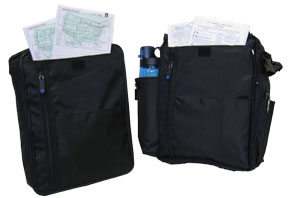
Getting a bag thats the right size for your needs is perhaps the biggest challenge in a flight bag. Too small, and you end up carrying a second bag. Too big and it gets in the way or, worse, you use it to store stuff at home rather than carry stuff to the aircraft.
Starting on the small end, the CFI bag was purpose built to carry just the essentials for the working CFI. Its a great idea, but we think it failed in execution here. The issue is use of space. The main compartment is large enough for any headset with room to spare, but not enough room for a GPS or Jepp binder as well. There were several small sleeves for charts and pens that work well, but no good place for sunglasses or foggles.
In contrast, the IFR bag is just a shade larger in volume, but holds all these items, if a bit tightly. The IFR came closest to meeting our all-around needs. It holds a single headset, GPS, charts, binders, miscellaneous tools and a water bottle while still fitting behind the seat in a Cessna 172 with a six-foot copilot sitting in front. Our biggest beef is that it would have been a good idea if it was all of one inch taller. you’ll stretch the zippers on the main pocket to get over that Jepp binder or a bulky headset standing upright. Overall, we really liked this bag, though, and recommend it for VFR or IFR pilots, particularly if you don’t need to carry all your paper charts.
Stepping up to the Flight Gear bag lets you carry everything you might want plus a change a clothes and a toothbrush. Organization is excellent, with a good mix of
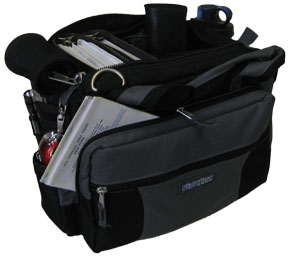
large, dump-all areas and purpose-built sleeves for a flashlight, cell phone and GPS. Four chart sleeves are gusseted so even a NACO chart book or AF/D fit in and out with ease. However, the extra chart area behind those pockets is one inch too short for upright charts, just like the IFR bag. Maybe somebody needs to buy these guys a ruler. The side pocket holds even an extra-long kneeboard.
The backpack is, in our opinion, not we’ll thought out. All the gear tends to fall to the bottom of two big pockets. Internal and external separators or pockets are few. There is a beaver tail to strap things on the back, but no way to tighten it down. There is an internal headset hanger using Velcro that would have been better served with a clip of some kind.
We applaud the improvements in heavy-duty construction and metal fittings. However, we had the stitching separate on the CFI bag and saw poor stitching on another bag. So quality control might be an issue, but Sportys has a reputation of making things right for customers who complain, so we don’t see that as a dealbreaker.
The key holder on most of the bags is great, but we would have preferred it to be
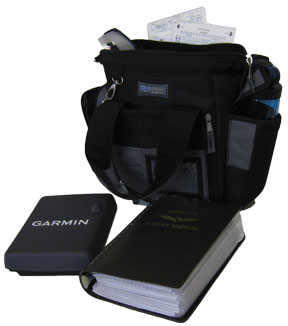
just inside a zipper so you didnt have to hear them jingling all the way across the ramp. Overall, the Sportys line has something that will work we’ll for just about any range of pilot need.
Sky High Bags
Wed never heard of Sky High bags until researching this article, but were glad we found them. They take the silver medal for excellent use of space, particularly for their Gemini bag. The Gemini is just a shade larger than Sportys IFR bag, but that shade means Jepp binders will fit standing on end and a kneeboard can be laid on top while still having the bag close easily.
The main compartment will hold even the biggest headsets, two sets of approach plates, the Garmin 696 we had for another article and still have space for flashlights, gloves and other miscellaneous stuff.
Keeping miscellaneous stuff separate is a shortcoming, though. Sky High bags were a bit short on pockets in the right places during our testing. For example, the bag has a great feature of a kind of chart library where you can quickly flip through and find the chart you want, but if you fill that with charts, you cant put anything in the pockets next to the charts-there isn’t enough space. We thought a pocket or
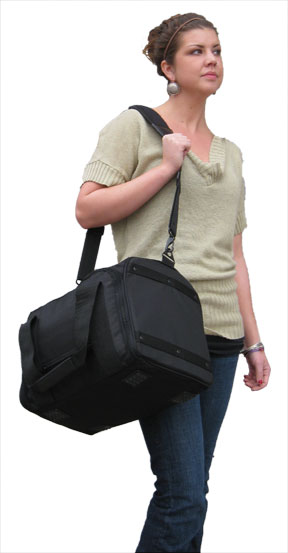
two on the outside of the bag for quick access to sunglasses or a flashlight would be good, too.
We also tried their Voyager bag, which is sort of a soft briefcase, and Freedom, which is a good day bag or CFI bag. The Voyager would work if you had a small laptop or EFB and a headset, but a large laptop wouldnt share the space well. Organization in the Voyager and the Gemini was excellent. Sky High also has a large bag, the Discovery, which we didnt test.
We saw some customer complaints about quality, but we didnt uncover any obvious defects. All the bags have a one-year, no-questions warranty.
ASAs Cockpit Organizers
We looked at two new bags from ASA: the CRM bag and the Tech bag, and were disappointed overall.
The CRM bag was the better of the two, and has the unique feature of zipping open such that it becomes a fully-accessible cockpit organizer sitting in the right seat. The concept works great, but we think the actual pocket sizes and shapes don’t use the space nearly as we’ll as they should. NACO plates, charts and an AF/D fit, but there’s no good place for a Jepp binder. There’s only one zip-close pocket on the inside, so miscellaneous items either all get stuffed there or they float around in the bag. Also there are many items, such as a headset, that you
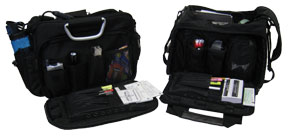
need to carry in your bag, but don’t need to be in your cockpit organizer section. And taking two bags rather defeats the purpose given that this is a fairly large bag already.
The Tech bag was supposed to be great for a laptop computer and it will definitely hold even a large one. Our beef again, though, was how it used the rest of the internal space. The larger pocket zips to lay flat while the bag stands up, but the dividers inside are short and don’t keep items we’ll separated. There is ample area for approach plates and charts, but its more a stuff-all area than a few right-sized pockets.
Wed still recommend ASAs Air Classics Flight bag. As you might expect from the name, its a classic flight bag layout with headset pockets on the ends and stuff in the middle. Its perhaps the smallest one of these types of bags, small enough to fit on the floor behind the seats in many aircraft. The headset pockets may be too small for bulky ANR headsets, however.
Jepp Bags
Jeppesen do one thing better than any other bag: hold Jepp binders. In fact, if we had to lug a bunch of Jepp binders around for serious, cross-country flying, wed
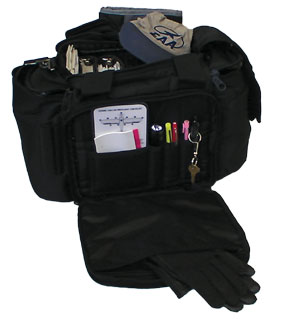
consider buying the Jepp Aviator bag for just that. Jepp also offers a plain Airway Manual bag for just binders, but this is more an open duffle that fits binders we’ll than a convenient bag.
Jepp bags are sturdy and we’ll padded, but short on organization or ease of use, in our opinion. For example, the side pocket only zips down part way, leaving you to hunt inside for items, while other bags zip down all the way for greater access. Jepp bags have a strap-on system for extra headset pockets or a GPS, thats faster than a zip-on, but less secure. Were not sure wed use this feature much in the real world, but it could be a selling feature if you are often taking or leaving extra headsets.
Most of the Jeppesen bags are quite large, so they can carry your gear and a couple days worth of clothing if need be. There is also a small, student bag, but its much simpler and less sturdy than several other options, in our view. It comes bundled with Jepps excellent student pilot curriculum, and is fine as a freebie, starter bag.
Still More Options
This roundup is far from all-encompassing, as there are plenty of other options out there, both from bags built specifically for pilots and general-purpose bags that work we’ll as flight bags.
Speaking of such, we were able to look briefly at the Topi shoulder bag by Zuluworks, which is designed as a flight bag but was being used by the owner as his briefcase. We werent able to get examples of the Zulu line to review for this article, but their offerings are somewhat unique and worth a look.
While there is no perfect bag for everyone, our perception is pilots often buy too much bag rather than too little. Lining up a bunch of these bags before pilots to evaluate only reinforced our feeling that small was beautiful. Check out some of these stuff-swallowing smaller bags for a solution that works.
Jeff Van West is Aviation Consumers managing editor.


